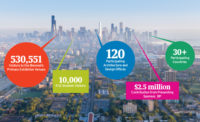One of the most anticipated museums to open in the U.S., the National Museum of African American History and Culture (NMAAHC) generated excitement before its doors even opened.
When President Barack Obama presided over the official opening last year on September 24, 2016, the NMAAHC became the first museum dedicated to honoring and remembering African American history and culture, as well as the newest and final addition to Washington, D.C.’s National Mall. It was the first new Smithsonian institution since the National Museum of the American Indian in DC opened in 2004.
To put it mildly, expectations were high for everyone, including architect David Adjaye, who viewed the project as "both monument and memorial."
The museum did not disappoint, having to supply an 80,000 additional passes in its first week in order to accommodate the amount of people waiting to visit. However, the success of any institution or building is not based only on first impressions.
Success for a structure like the NMAAHC is also measured by its performance over time—a story best told by numbers—so here’s how NMAAHC’s first year looked, according to the museum’s data:
- Almost 2.5 million visitors walked through the 400,000-square-foot building.
- Of those visitors, 922 were ambassadors.
- About 10,000 of all 2.5 million people who passed through were between the ages of 4 and 7 years old.
- About 3,000 objects were on display while NMAAHC’s permanent collection is more than 13 times that size, at almost 40,000 objects.
- NMAAHC hosted 46 public events, including 3 movie premiers.
- Every day, visitors bought 2,500 meals at the museum’s built-in restaurant, Sweet Home Café, which went through about 1,000 pounds of collard greens, 500 pounds of local blue catfish, and 400 pounds of trout each week.
- The building uses 19,400 gallons of water per day, captured from condensation, rain, and ground water.
- The museum published 9 books and 33 scholarly articles.
- Finally, 301 photovoltaic panels produced 122, 803 kilowatt hours for the building; NMAAHC is hoping to receive its LEED Gold certification in 2017.







Post a comment to this article
Report Abusive Comment